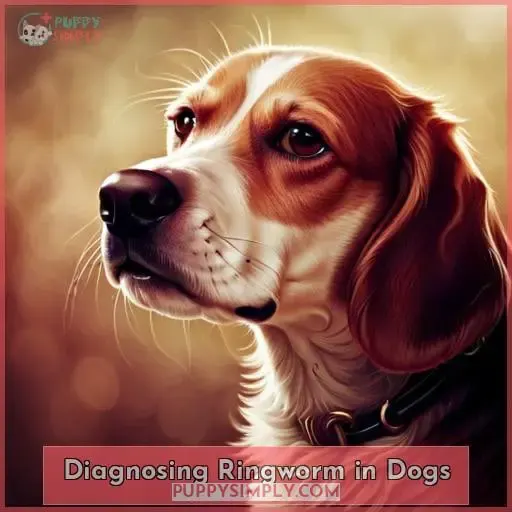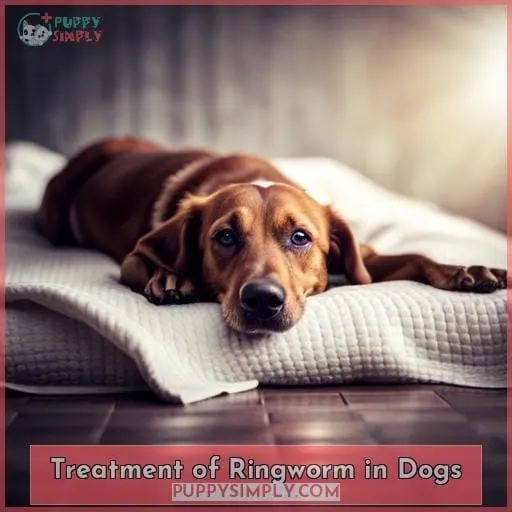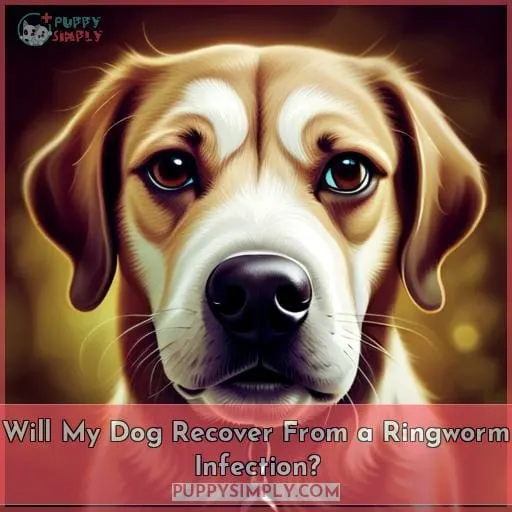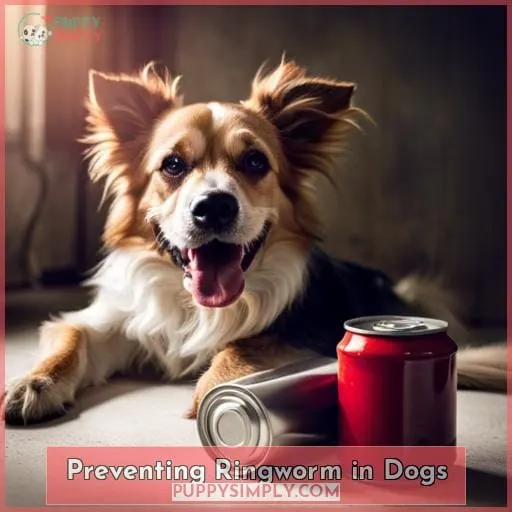This site is supported by our readers. We may earn a commission, at no cost to you, if you purchase through links.
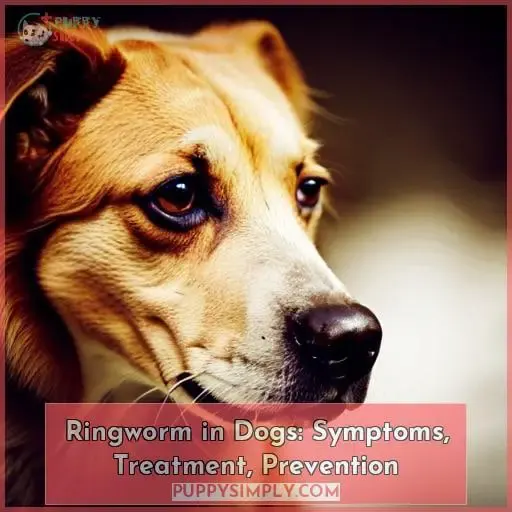 Imagine your dog with a round, hairless patch on their skin that looks like a tiny volcano. This could be a sign of ringworm, a contagious fungal infection that can affect dogs and humans alike.
Imagine your dog with a round, hairless patch on their skin that looks like a tiny volcano. This could be a sign of ringworm, a contagious fungal infection that can affect dogs and humans alike.
In this article, you will discover:
- The symptoms to look out for in your furry friend
- Effective treatment options available
- Practical ways to prevent ringworm from spreading further
Stay informed about ringworm in dogs to keep both your pet and yourself safe from this pesky infection.
Table Of Contents
- Key Takeaways
- What Does Ringworm Look Like in Dogs?
- Diagnosing Ringworm in Dogs
- Can You Get Ringworm From Your Dog?
- How is Ringworm in Dogs Spread?
- Can Other Animals Get Ringworm?
- Can Humans Get Ringworm?
- Treatment of Ringworm in Dogs
- How Long Will My Dog Be Contagious?
- Will My Dog Recover From a Ringworm Infection?
- Preventing Ringworm in Dogs
- Frequently Asked Questions (FAQs)
- What are the long-term effects of ringworm in dogs if left untreated?
- Can ringworm be transmitted from dogs to other household pets, such as cats or rabbits?
- Are there any natural remedies or home remedies that can effectively treat ringworm in dogs?
- Can a dog still be contagious for ringworm even after completing the full treatment course?
- Is there a vaccine available to prevent ringworm infections in dogs?
- Conclusion
Key Takeaways
- Ringworm is a contagious fungal infection that affects both humans and animals, including dogs.
- The infection can be spread through direct contact with an infected animal or person, contaminated objects, or shedding hairs.
- Oral medications, such as antifungal drugs, are often prescribed for treatment and may need to be taken for several weeks or months.
- Thorough cleaning and disinfection of the dog’s environment is crucial to prevent reinfection and ensure successful treatment outcomes.
What Does Ringworm Look Like in Dogs?
Ringworm in dogs commonly presents as:
- Circular areas of hair loss, often accompanied by a crusty covering or scaly patches on the skin.
- The lesions are red and raised, with a clear center.
- One distinctive feature is the presence of fragile, easily broken hair shafts around the affected area.
- In some cases, there may be a scabbed covering on inflamed lesions.
To accurately diagnose ringworm in dogs, veterinarians can use a Wood’s lamp examination to detect fluorescence under ultraviolet light.
It’s important to note that not all cases of ringworm will fluoresce under this lamp; therefore additional diagnostic methods such as microscopic examination and culture may be necessary for confirmation.
Diagnosing Ringworm in Dogs
To diagnose ringworm in dogs, your veterinarian will perform a combination of clinical examinations and laboratory tests.
- Clinical Examinations:
- Your veterinarian will visually examine your dog’s skin for characteristic signs of ringworm, such as circular areas of hair loss with a crusty covering or red lesions.
- They may also look for broken hair shafts or scabby coverings on inflamed lesions.
- Microscopic Examination:
- Skin scrapings from the affected areas may be taken to be examined under a microscope for the presence of fungal elements called dermatophytes. This test helps confirm if there are indeed fungal spores present and causing the infection.
- Wood’s Lamp Examination:
- A wood’s lamp examination involves shining an ultraviolet light onto your dog’s skin to check if any fluorescent reactions occur that could indicate ringworm infection.
- Culture Test:
- The most accurate way to diagnose ringworm is through culture testing, where samples from infected areas are collected and sent to a laboratory for analysis under specific lab conditions.This test takes about 10 days before results can be obtained but provides valuable information regarding which species-specific fungus is responsible.
It’s important to note that false negatives can sometimes occur with these tests due to various factors like inadequate sample collection or insufficient growth of fungi in cultures.After confirming positive diagnosis,treatment typically lasts between 4-6 weeks.Topical therapy along with systemic drugs are often recommended.
Environmental decontamination plays crucial role in preventing reinfection by eliminating any remaining spores.With proper diagnosis and treatment,your furry friend will soon recover from this common fungal infection.
Can You Get Ringworm From Your Dog?
You can contract ringworm from your dog through direct contact or by touching contaminated objects.
Ringworm is a fungal infection that can affect both humans and animals, including dogs, cats, horses, and rabbits.
The fungus responsible for most cases of ringworm in dogs is Microsporum canis. Humans are also susceptible to this specific strain of ringworm.
It’s important to note that while the symptoms may be similar between species, the treatment options may differ slightly.
To better understand the transmission of ringworm between different species, here’s a comparison table:
| Ringworm in Dogs | Ringwoorm in Humans | |
|---|---|---|
| Risk Factors | Young age | Weakened immune system |
| Symptoms | – Circular areas of hair loss | – Red circular rash |
| – Fragile hair shafts | – Itchy sensation | |
| – Inflamed lesions with scabby covering | – Hair loss |
If you suspect that you or your dog has contracted ringworm from each other or another source,
it’s essential to seek veterinary care for your pet and consult with a healthcare professional for proper diagnosis and treatment recommendations.
Remember to practice good hygiene habits when handling infected pets
and take necessary precautions to prevent spreading the infection among family members and other animals.
How is Ringworm in Dogs Spread?
The spread of ringworm in dogs occurs through direct contact with an infected animal, person, or contaminated object.
- Direct Contact: Ringworm can be transmitted when your dog comes into contact with another infected animal or person. This includes activities such as playing, grooming, or sharing bedding.
- Contaminated Objects: Fungal spores that cause ringworm can survive on surfaces and objects for extended periods of time – up to 18 months in some cases! Your dog can contract the infection by touching these contaminated objects like brushes, toys, blankets, or even furniture.
- Shedding Hairs: Infected animals shed hairs that contain fungal spores which contribute to environmental contamination and increase the risk of spreading the disease.
- Incubation Period: After exposure to ringworm fungus from a contagious source (animal/person/object), it takes about 1-4 weeks for symptoms to appear in your dog.
Can Other Animals Get Ringworm?
Now that you know how ringworm is spread among dogs, let’s explore whether other animals can also get infected.
Livestock such as cattle, sheep, and horses are susceptible to the infection. Additionally, wildlife such as squirrels and rabbits have been known to carry the fungus responsible for ringworm.
It’s important to note that while these animals may carry the fungal spores that cause ringworm, they mightn’t display any symptoms themselves. However, they can still transmit the infection to humans or other pets if direct contact occurs.
If you have concerns about your dog coming into contact with livestock or interacting with wild animals during walks or outdoor activities in areas where these creatures reside – it would be wise to consult your veterinarian on preventive measures.
Can Humans Get Ringworm?
Humans can contract ringworm from their dogs.
Ringworm is a contagious fungal infection that can be transmitted through:
- Direct contact with an infected dog
- Touching contaminated objects
People with weakened immune systems are more susceptible to contracting ringworm from their pets.
The symptoms of ringworm in humans include:
- The appearance of red, itchy lesions that often form a circular shape on the skin, resembling a red circle.
If you notice these symptoms after your dog has been diagnosed with ringworm, it’s important to seek medical attention from your primary care physician.
Treatment for human cases of ringworm typically involves antifungal creams or oral medications prescribed by a healthcare professional.
Taking precautionary measures such as practicing good hygiene and avoiding close contact with infected animals can help prevent the spread of this contagious infection between humans and pets.
Treatment of Ringworm in Dogs
When it comes to treating ringworm in dogs, there are two main approaches:
- Oral medications
- Environmental decontamination
Oral medications, such as antifungal drugs, are often prescribed by veterinarians to kill the fungus in the body. These medications may need to be taken for several weeks or months depending on the severity of the infection.
In addition to medication, thorough cleaning and disinfection of your dog’s environment is crucial to prevent re-infection and ensure successful treatment outcomes.
Oral Medications
To effectively treat ringworm in dogs, your veterinarian may recommend the use of oral medications. These medications can help kill the fungus causing the infection from within your dog’s body.
Here are five important things to know about oral medications for treating ringworm in dogs:
- Oral medications are usually prescribed alongside topical therapy for maximum effectiveness.
- The dosage and duration of treatment will depend on several factors, including the severity of the infection and your dog’s overall health.
- It’s important to follow your vet’s instructions carefully when administering oral medication to ensure proper efficacy.
- Like any medication, there may be potential side effects associated with oral treatments for ringworm in dogs. Your vet will discuss these with you before starting treatment.
- The cost of oral medications can vary depending on factors such as brand and dosage strength, so it’s best to consult with your veterinarian regarding pricing options available.
Environmental Decontamination
Cleanse your dog’s environment thoroughly to prevent the spread of ringworm.
Decontamination should be performed regularly and with appropriate cleaning products to eliminate fungal spores from surfaces.
Areas that should be decontaminated include:
- Bedding
- Toys
- Grooming tools
- Floors
- Any other objects or surfaces that may have come into contact with the infected dog.
It’s important to continue decontamination for a duration of at least 2-4 weeks or as recommended by your veterinarian.
Avoid direct contact with these areas during this time to minimize the risk of reinfection.
How Long Will My Dog Be Contagious?
Your dog will remain contagious with ringworm until appropriate treatment has been administered and the infection is fully resolved. After starting treatment, it’s important to understand how long your dog may still be contagious to prevent the spread of ringworm.
- 1 week after treatment: At this point, there should be some improvement in the symptoms and the risk of spreading ringworm decreases.
- 2 weeks after treatment: The lesions should start to heal, and there’s a lower chance of transmitting the infection.
- 3 weeks after treatment: Your dog is likely no longer shedding infectious spores and can interact safely with other animals or people.
- 2 months after treatment: It usually takes this amount of time for all traces of ringworm to completely clear from your pet’s system.
- 6 months after treatment: This period allows for monitoring any potential recurrence or reinfection.
Remember that each case may vary slightly, so it’s essential to follow up with regular check-ups by your veterinarian even if you believe your dog has recovered fully.
Will My Dog Recover From a Ringworm Infection?
Your dog’s recovery from a ringworm infection will depend on various factors. While treatment is essential for eliminating the fungus and preventing further spread, it’s also important to consider the duration of treatment, the immune system response, and potential risk factors for relapse.
The table below summarizes key information about your dog’s recovery process.
| Factors Affecting Recovery | Information |
|---|---|
| Duration of Treatment | The length of time required for complete resolution can vary depending on multiple factors such as severity of infection and individual response to medication. Typically, treatment lasts between 4-8 weeks or longer if necessary. |
Contagious Period
Preventing Ringworm in Dogs
To prevent ringworm in your dog, it’s important to take certain preventive measures.
- Start by giving your dog regular baths using an antifungal shampoo recommended by your veterinarian. This will help keep their skin clean and reduce the risk of infection.
- Additionally, consider trimming your dog’s nails regularly with clippers to prevent them from scratching and potentially spreading the fungus if they’re already infected.
- Another crucial step in preventing ringworm is to vacuum carpets and soft furnishings thoroughly. Ringworm spores can survive on these surfaces for a long time, so removing them through frequent vacuuming can significantly reduce the risk of transmission.
- Using a disinfectant spray on objects that may have come into contact with an infected animal is also essential for prevention. Pay special attention to items like bedding, toys, and grooming tools as these can harbor fungal spores.
- Lastly, if you suspect or know that your dog has ringworm, it’s crucial to quarantine them in a separate room until they’ve been treated effectively. This helps contain the spread of infection within your home.
By following these preventive measures consistently and maintaining good hygiene practices for both yourself and your pet, you can greatly minimize the chances of contracting or spreading ringworm infections.
Frequently Asked Questions (FAQs)
What are the long-term effects of ringworm in dogs if left untreated?
If left untreated, ringworm in dogs can lead to:
- Persistent and worsening skin infections.
- The fungus can spread to other pets or humans in the household, causing discomfort and potential health risks.
Prompt treatment is crucial for preventing long-term effects.
Can ringworm be transmitted from dogs to other household pets, such as cats or rabbits?
Ringworm can be transmitted from dogs to other household pets, such as cats or rabbits.
It’s important to isolate the infected dog and seek veterinary care for all affected animals to prevent the spread of ringworm within your home.
Are there any natural remedies or home remedies that can effectively treat ringworm in dogs?
To effectively treat ringworm in dogs, it’s recommended to consult with a veterinarian for the best course of action.
While there are natural remedies and home remedies suggested online, their effectiveness may vary and professional guidance is crucial for your dog’s well-being.
Can a dog still be contagious for ringworm even after completing the full treatment course?
Yes, a dog can still be contagious for ringworm even after completing the full treatment course. It’s important to continue practicing good hygiene and environmental decontamination to prevent the spread of infection.
Is there a vaccine available to prevent ringworm infections in dogs?
Unfortunately, there’s currently no vaccine available to prevent ringworm infections in dogs. However, proper hygiene practices and regular veterinary care can help reduce the risk of your dog contracting this contagious fungal infection.
Conclusion
To conclude, ringworm in dogs is a contagious fungal infection that can also affect humans.
Recognizing the symptoms, such as round, hairless patches on your dog’s skin, is crucial for early detection.
Diagnosing ringworm in dogs requires veterinary assistance, and treatment options include oral medications and environmental decontamination.
It’s important to note that ringworm can spread easily, both among animals and to humans.
Taking preventive measures, such as practicing good hygiene and keeping your dog’s living area clean, can help minimize the risk of ringworm infection.


